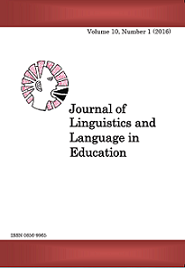Variation in Subject-Verb Agreement Marking in Two Kibena Dialects: The Highland Dialect and the Lowland Dialect
Abstract
Many traditional dialectologists tend to describe language dialects in favour of
phonological and lexical analysis. This paper is a comparative description of
variation in subject-verb agreement marking between two Kibena varieties: the
Highland Dialect (HD) and Lowland Dialect (LD). This study is guided by the
Bantu Divergence-Convergence Theory. The findings reveal that in both the
HD and the LD, subject prefixes obligatorily co-occur with all personal
pronouns and all noun classes. Unlike in HD, nouns denoting animals take
agreements from class 1/2 in LD. For coordinated subject noun phrase,
semantic and morphological criteria are used for subject-verb agreement
marking in HD. For LD, three strategies are employed: semantic, syntactic and
morphological criteria. The variation in agreement marking between the HD
and LD is contributed by geographical and historical factors, as well as
language contact. This analysis provides evidence that both HD and LD are
still varieties of Kibena.
References
Chaula, E. H. Y. (2017). Properties of Word Categories in Kibena:
Nouns, Verbs and Adjectives. Unpublished PhD Thesis,
University of Dar es Salaam.
Berger, C. B., Glaser, E. & Seiler, G. (2010). Is a Syntactic
Dialectology Possible? Contributions from Swiss German.
Retrieved from
Perida Mgecha | 113
http://www.zora.uzh.ch/64838/1/Bucheli_Berger_et_al_Is_a_sy
ntactic dialectology_possible.pdf
Diercks, M., Meyer, L. & Paster, M. (2015). Agreement with
Conjoined Arguments in Kuria. Studies in African Linguistics,
(1): 27􀂲46.
Guthrie, M. (1948). The Classification of Bantu Languages. London:
Oxford University Press.
Guthrie, M. (1967􀂲1971). Comparative Bantu: An Introduction to the
Comparative Linguistics and Prehistory of Bantu Languages,
(Vol. 1􀂲4). Letchworth UK and Brookfield VT: Cregg
International.
Hans, M. M. (2014). Mchango wa Lahaja katika Kukuza na
Kuendeleza Kiswahili Sanifu: Hazina Fiche Iliyomo katika
Lahaja za Kiswahili za Zanzibar. Unpublished PhD Thesis,
University of Dar es Salaam.
Hinnebusch, T. J. (1999). Contact and Lexicostatistics in
Comparative Bantu Studies. In J. M. Hombert & L. M.
Hyman (eds.). Bantu Historical Linguistics: Theoretical and
Empirical Perspectives (Lecture Notes 99). Stanford: CSLI:
􀂲205.
Kanana, F. E. (2011). Meru Dialects: The Linguistic Evidence. Nordic
Journal of African Studies, 20(4): 300􀂲327.
Katamba, F. (2003). Bantu Nominal Morphology. In D. Nurse & G.
Philippson (eds.). The Bantu Languages. London: Routledge:
􀂲120.
Kipacha, A. (2003). Lahaja za Kiswahili. Dar es Salaam: The Open
University of Tanzania.
Languages of Tanzania Project. (2009). Atlasi ya Lugha za Tanzania.
Dar es Salaam: University of Dar es Salaam.
Lusekelo, A. (2013). DP-internal and V-external Agreement Patterns
in Bantu: Re-statement of the Facts on Eastern Bantu
Languages. Journal of Linguistics and Language in
Education, 7(1): 19􀂲47.
Maho, J. F. (2009). A Referential Classification of the Bantu
Languages. Retrieved from
goto.glocalnet.net/mahopapers/nuglonline.pdf
Marten, L. (2000). Agreement with Conjoined Noun Phrases in
Swahili. Afrikanistische Arbeitspapiere, 64 (Swahili Forum
VII): 75􀂲96.
Massamba, D. P. B. (2007). Kiswahili Origins and the Bantu
Divergence-Convergence Theory. Dar es Salaam: Taasisi ya
Uchunguzi wa Kiswahili.
| Variation in Subject-Verb Agreement Marking in Two Kibena Dialects
Massamba, D. P. B. (2018). Kiswahili Origins and the Bantu
Divergence-Convergence Theory. Internatinal Journal of
Bantu Linguistics, 1: 1􀂲24.
Matei, A. K. (2008). Darubini ya Sarufi: Ufafanuzi Kamili wa Sarufi
ya Kiswahili. Nairobi: Phoenix Publishers.
Mgecha, P. (2019). Classification of Kibena Dialects Using
Morphosyntactic Parameters. Unpublished PhD Thesis,
University of Dar es Salaam.
Mitchley, H. (2015). Agreement and Coordination in Xitsonga,
Sesotho and Isixhosa: An Optimality Theoretic Persipective.
Unpublished M.A. Thesis, Rhodes University.
Mitterhofer, B. (2013). Lessons from a Dialect Survey of Bena:
Analysing Wordlists. University of Leiden: SIL International.
Morrison, M. (2015). Dialect Variation in a Minority Language: The
Case of Bena. In R. Kramer, E. C. Zsiga & O. T. Boyer (eds.).
Selected Proceedings of the 44th Annual Conference on
African Linguistics, 199-211. Somerville, MA: Cascadilla
Proceedings Project.
Mtenje, A. A. (2016). A Comparative Analysis of the Phonology and
Morpho-Syntax of Cisukwa, Cindali and Cilambya.
Unpublished PhD Thesis, University of Cape Town.
Nurse, D. & G. Philippson. (2003). Towards a Historical
Classification of the Bantu Languages. In D. Nurse & G.
Philippson (eds.). The Bantu Languages. Richmond: Curzon:
􀂲181.
Nyagava, S. I. (2000). A History of the Bena to 1914. Iringa,
Tanzania: Iringa University.
Petzell, M. & Hammarström, H. (2013). Grammatical and Lexical
Comparison of the Greater Ruvu Bantu Languages. Nordic
Journal of African Studies, 22(3): 129􀂲157.
Riedel, K. (2010). Fipa: A First Look at Dialectal Variation and
Syntactic Variation. ZAS Papers in Linguistics. Retrieved
from https:www.researchgate.net/...228584451
Sibajene, A. (2013). A Dialectological Study of Tonga. Unpublished
M.A. Thesis, The University of Zambia.
Taji, J. & Mreta, A. (2014). Subject-Verb Agreement in Chiyao
Conjoined Noun Phrases. Journal of Linguistics and Language
in Education, 8(2): 78􀂲88.
Taji, J. (2017). The Morphosyntactic and Semantic Properties of
Grammatical Relations in Chiyao. Unpublished PhD Thesis,
University of Dar es Salaam.
Yoneda, N. (2010). Topical Hierarchy and Grammatical Agreement
in Matengo (N13). In K. Legere & K. Thornell (eds.). Bantu
Perida Mgecha | 115
Languages: Analyses, Description and Theory. Koln: Rudiger
Koppe Verlag.
Zeller, J. (2008). The Subject Marker in Bantu as an Antifocus
Marker. Stellenbosch Papers in Linguistics, 38, 221􀂲254.
Downloads
Published
Issue
Section
License
Copyright © by Department of Foreign Languages and Linguistics, University of Dar es Salaam
All rights reserved. No part of this publication may be reproduced or transmitted in any form or by any means, electronic or mechanical, including photocopying, recording, or any information storage or retrieval system, without permission in writing from the publisher, except for short extracts in fair dealing, for research or private study, critical scholarly review or discourse with an acknowledgement.



